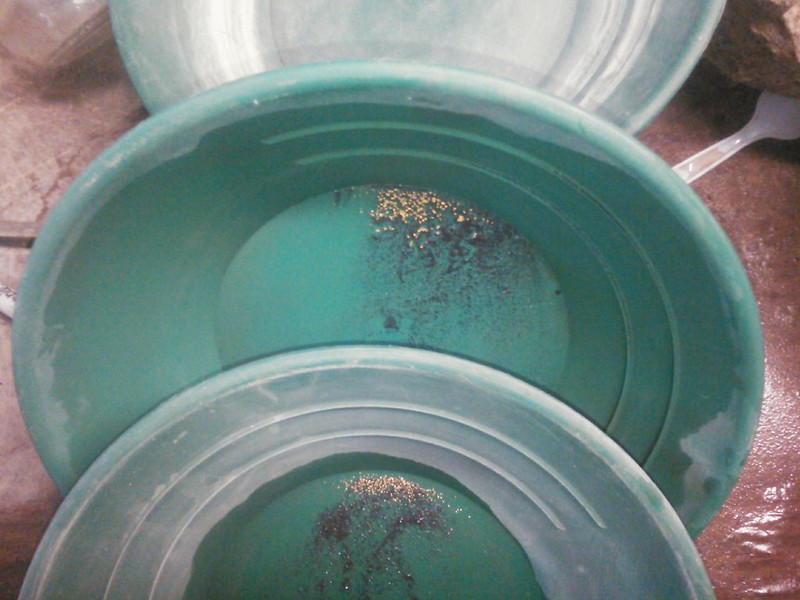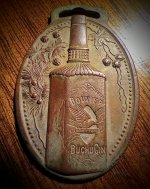bobw53
Hero Member
I'm not sure how to describe this..
Gold bearing area, its not huge, its not California or even Arizona.. It was hit HARD from the 1870's and up. Gold rush town and all.
Lots of hard rock, and lots of placer.. Hard rock to the west, placer to the east.. Dry land dredge and all that to the east.. Looks
like piles of intestines left over. However, I think they missed something.. to the south east. Over a hundred years after the rush,
rains and floods have cut their way into desert meadows and shallow desert valleys and have exposed some pretty gravels and created
new arroyos... AND GOLD!!!
So I've been playing around in that gravel layer for a while. And its been pretty damn good. HARD digging, but its the best
gold I've found so far...
10 buckets, half to two thirds full... This doesn't hurt my feeling any. 20-50 and 50-80.

Horrible pic, but I can see the layer... If you were standing there, you could see it. See where the score marks of the pick STOP... That's where the
layer STARTS. .

So I went out on Friday.. Looking at something "new".. About a mile further from "the source". Where the water finally decided to drop and
CUT into the ground... and there is that gravel again. WAY FAR off the beaten path.. I only grabbed 4 really short buckets off the
bottom, easy digging stuff. Sucked, but better than some other places I've tried. This area hasn't been under claim in over 20 years.
That layer is a little thin and narrow here, over on the left... CAMO dog on the right (why I try and put her yellow vest on her, when I can find it
she blends in to the desert background way too well).

Spin around 180 degrees and walk 20 feet and we(I) have this.. That wall on the bottom right looks pretty sexy to me. That layer
of big heavy gravel.

I think its worth at least 2 more trips.. DIGGING into that gravel... See whats there...
Sad thing is, the pics don't do those cuts any justice, they make them look a lot wider and
shallower than they are.

This cut is well over the top of my head, and it doesn't look that way.. And its maybe 8 foot
wide. Gets HOT down there... There was a nice breeze Friday afternoon, you don't
get any of that down in those cuts, just the heat, kicks you in the nuts.... And no
my dog doesn't have a tail.. She came that way, I didn't do it, and everything on my
coffee table is thankful.
Front end of the dog, with one of the other dogs.... And NO!!!!! it wasn't my idea to get a chihuahua, but he's cool... Spud-Lee.
His rapper name is "Little-Arf-Arf".

Gold bearing area, its not huge, its not California or even Arizona.. It was hit HARD from the 1870's and up. Gold rush town and all.
Lots of hard rock, and lots of placer.. Hard rock to the west, placer to the east.. Dry land dredge and all that to the east.. Looks
like piles of intestines left over. However, I think they missed something.. to the south east. Over a hundred years after the rush,
rains and floods have cut their way into desert meadows and shallow desert valleys and have exposed some pretty gravels and created
new arroyos... AND GOLD!!!
So I've been playing around in that gravel layer for a while. And its been pretty damn good. HARD digging, but its the best
gold I've found so far...
10 buckets, half to two thirds full... This doesn't hurt my feeling any. 20-50 and 50-80.

Horrible pic, but I can see the layer... If you were standing there, you could see it. See where the score marks of the pick STOP... That's where the
layer STARTS. .

So I went out on Friday.. Looking at something "new".. About a mile further from "the source". Where the water finally decided to drop and
CUT into the ground... and there is that gravel again. WAY FAR off the beaten path.. I only grabbed 4 really short buckets off the
bottom, easy digging stuff. Sucked, but better than some other places I've tried. This area hasn't been under claim in over 20 years.
That layer is a little thin and narrow here, over on the left... CAMO dog on the right (why I try and put her yellow vest on her, when I can find it
she blends in to the desert background way too well).

Spin around 180 degrees and walk 20 feet and we(I) have this.. That wall on the bottom right looks pretty sexy to me. That layer
of big heavy gravel.

I think its worth at least 2 more trips.. DIGGING into that gravel... See whats there...
Sad thing is, the pics don't do those cuts any justice, they make them look a lot wider and
shallower than they are.

This cut is well over the top of my head, and it doesn't look that way.. And its maybe 8 foot
wide. Gets HOT down there... There was a nice breeze Friday afternoon, you don't
get any of that down in those cuts, just the heat, kicks you in the nuts.... And no
my dog doesn't have a tail.. She came that way, I didn't do it, and everything on my
coffee table is thankful.
Front end of the dog, with one of the other dogs.... And NO!!!!! it wasn't my idea to get a chihuahua, but he's cool... Spud-Lee.
His rapper name is "Little-Arf-Arf".

Upvote
0





